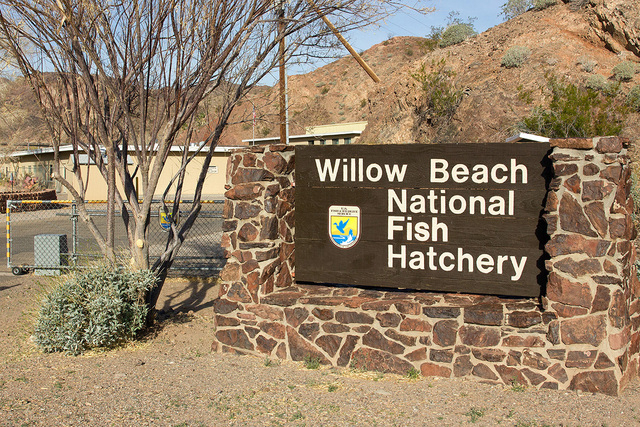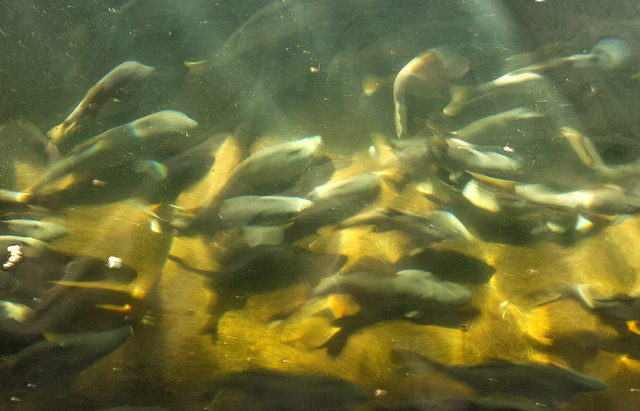Rainbows to shine again at Willow Beach Hatchery


It was just about 15 months ago that the U.S. Fish and Wildlife Service announced the end of rainbow trout production at the Willow Beach National Fish Hatchery. That decision had far-reaching implications, not only for anglers but also for the economies of communities on both sides of the Colorado River — communities such as Laughlin, Nev., and Bullhead City and Kingman, Ariz. Communities that depend on fishing-based tourism for revenue.
Now, months of hand wringing, letter writing and public meetings later, hope is no longer on the horizon. Hope has arrived. It came March 4 when the Arizona Game and Fish Department (AZGFD), Mohave County, Ariz., and the U.S. Fish and Wildlife Service (FWS), successfully executed agreements that will restore rainbow trout stocking at the Willow Beach Hatchery, the very purpose for which the facility was originally built along the cold waters of the Colorado River more than 50 years ago.
According to a news release from Sen. John McCain’s, R-Ariz., office, the agreement calls for the installation of a new pump to supply Colorado River water to the hatchery’s rearing ponds. The estimated cost of the repairs is $776,000, which will be cost-shared by the AZGFD and the FWS. Each agency, then, can expect to pay about $338,000 for its share of the costs.
In addition to replacing the water pump, the agreement ensures that trout will be trucked to Lake Mohave on a temporary basis until repairs are complete. Moreover, the FWS will produce rainbow trout for stocking in the Colorado River for five years, supply 2 million triploid rainbow trout eggs to the AZGFD annually for five years, and supply 160,000 Apache trout eggs to the Department for 10 years. And since you can’t have a government agreement without meetings, the FWS will coordinate annually with the AZGFD in regards to these efforts.
“The agreement will have a tremendous impact on the local and state economy,” said. McCain, “… trout fishing supports around 1,700 jobs and generates approximately $75 million in economic activity along the Mohave County/Clark County stretch of the Lower Colorado River.”
Adding his two cents to the celebratory comments was Rep. Paul Gosar, R-Ariz., who also addressed the positive impact the Willow Beach agreement will have on jobs for his constituents. He also made it a point to recognize the agreement’s impact on “sportsmen throughout the country,” as well as those countless individuals who “stepped up and deserve thanks for speaking out after trout stocking was arbitrarily terminated. I’m proud that our collective efforts will protect trout fishing in Mohave County for future generations and I was honored to play an important role in saving this worthwhile program.”
Will this mean an eventual resumption of weekly trout plants? I don’t yet have the answer to that. Time will tell I suppose. The first step is getting the hatchery up and running on the trout side of life.
While this agreement is good news for anglers and communities alike, I can’t understand why there are time limits on the trout rearing services the hatchery will provide. Why, for instance, is there a five-year time frame established for the rearing of rainbow trout to be planted in the Colorado River? And what does that mean for anglers when the five years are past? I guess time will tell.
In the old days folks made a habit of watching their back trail for signs of danger. Going forward, I think anglers should do the same when it comes not only to the Willow Beach Hatchery but also the entire National Fish Hatchery System. Vigilance is the key to ensuring our kids and grandkids have the opportunity to feel the tug of a trout on the end of the line.
In the meantime, revel in the moment, but don’t expect the hatchery to begin shipping trout anytime soon. It is going to take some time for the trout side of the facility to get up and running. Once the water system is functioning correctly, it will take additional time for trout to grow to planter size — a full year if they start as eggs. A little less time if they come in as fingerlings.
Freelance writer Doug Nielsen is a conservation educator for the Nevada Department of Wildlife. His “In the Outdoors” column, published Thursday in the Las Vegas Review-Journal, is not affiliated with or endorsed by the NDOW. Any opinions he states in his column are his own. He can be reached at intheoutdoorslv@gmail.com.












